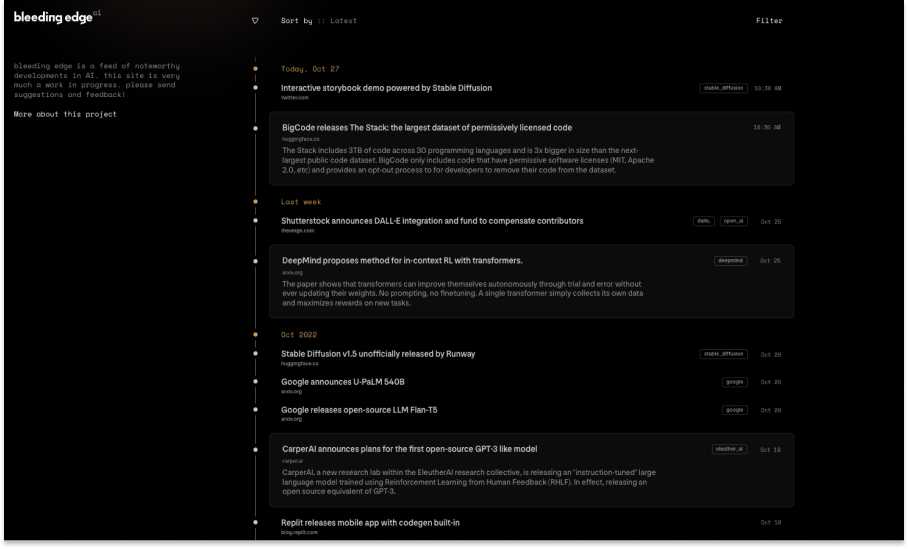

Weekly Dose of Optimism #18
source link: https://www.notboring.co/p/weekly-dose-of-optimism-18
Go to the source link to view the article. You can view the picture content, updated content and better typesetting reading experience. If the link is broken, please click the button below to view the snapshot at that time.

Weekly Dose of Optimism #18
The Crypto Story, IEA Calling Top, Data Lasers, Schumpeter's Workout Plan, ML-Powered Drug Discovery, Bleeding Edge AI
Come for the Optimism, stay for the in-depth analyses of tech companies and trends:
Hi friends 👋,
Happy Friday and welcome to our 18th Weekly Dose of Optimism. Go Phils.
The Weekly Dose is brought to you by…Secureframe
Answering RFPs and security questionnaires is critical to closing deals and growing revenue. But the manual process can delay deals or stop them cold. Secureframe helps you respond to both fast with machine learning so you can quickly build trust with customers, close more deals, and accelerate speed to revenue. Click here to schedule a demo of AI-powered Secureframe Questionnaires today.
(1) The Crypto Story
Matt Levine for Bloomberg
Conversely, I didn’t sit down and write 40,000 words to tell you that crypto is dumb and worthless and will now vanish without a trace. That would be an odd use of time. My goal here is not to convince you that crypto is building the future and that if you don’t get on board you’ll stay poor. My goal is to convince you that crypto is interesting, that it has found some new things to say about some old problems, and that even when those things are wrong, they’re wrong in illuminating ways.
When Matt Levine writes, we read. After years of coverage, Levine collected his thoughts on “Crypto” in this 40,000 word super-deep-dive. Levine’s perspective is an important one: he’s neither a crypto shill or arrogant skeptic. He’s a finance nerd. He might be the finance nerd. On crypto, he appreciates the value of trustless systems, calls-out bad behavior and naked speculation, and thinks that whatever is happening — good or bad—is important, or at least illuminating, for the broader financial ecosystem.
We won’t attempt to summarize the essay here — it’s 40,000 words and Levine covers a bunch of different topics — but if you have a couple hours over the weekend, we recommend you take the time to read it. Or you can listen to Levine explain the story (and why he wrote it) in this interview with Vox’s Peter Kafka.
Levine’s whole piece, culminating in this final image, is a great expression of the brand of optimism we strive for: deep research, a lot of words, a recognition of the challenges, and a belief that it’s worth trying to build better products and systems despite them.
From The International Energy Agency
For the first time, a WEO scenario based on prevailing policy settings has global demand for each of the fossil fuels exhibiting a peak or plateau. In the STEPS, coal use falls back within the next few years, natural gas demand reaches a plateau by the end of the decade, and rising sales of electric vehicles (EVs) mean that oil demand levels off in the mid-2030s before ebbing slightly to mid-century. Total demand for fossil fuels declines steadily from the mid-2020s by around 2 exajoules per year on average to 2050, an annual reduction roughly equivalent to the lifetime output of a large oil field.
The IEA callin’ the top! This isn’t the first time people have called peak oil: I remember talking about near-term peak oil predictions in my Energy & Economics class in college. But the numbers are compelling.
Despite a rise in fossil fuel usage this year, the IEA believes we are near the peak of global fossil fuel usage and embarking on a long, slow, but necessary course towards a cleaner energy future. There’s much work to be done, however. We do not currently have nearly the clean energy capacity to fully replace fossil fuel usage and we’ll likely need breakthrough innovations in some combination of nuclear, solar, wind, fusion, hydrogen, and battery technologies to fully replace fossil fuels on the schedule that we want to.
Thankfully, we are just a few desecrated masterpieces away from killing fossil fuels. Potato mashing our way towards a cleaner future. (For the avoidance of doubt: we’re kidding! These protests are unimaginably and embarrassingly dumb.)
(3) New data transmission record set using a single laser and a single optical chip
Lotte Krull for Phys.Org
h/t … Ashton Kutcher?
In the experiment, the researchers succeeded in transmitting 1.8 Pbit/s, which corresponds to twice the total global Internet traffic. And only carried by the light from one optical source. The light source is a custom-designed optical chip, which can use the light from a single infrared laser to create a rainbow spectrum of many colors, i.e., many frequencies. Thus, the one frequency (color) of a single laser can be multiplied into hundreds of frequencies (colors) in a single chip.
Kutch from way downtown!
A team of researchers achieved record-breaking data transmission speeds, moving more than 1.8 petabits per second using only a single laser and optical chip. That’s a lot of data — nearly 2x the daily global internet traffic. And the team is able to accomplish this using a single optical chip.
Without getting too much into the detail on the chip, this is an important breakthrough because one of these chips could replace 1,000s of lasers and when scaled, in aggregate, these chips could replace hundreds of thousands of lasers at internet hubs and data centers across the world. We’re not there yet — commercialization is still a few years out — but this eventual swap could significantly reduce the climate footprint of the internet.
(4) Time to Get Fit — an Open Letter from Altimeter to Mark Zuckerberg (and the Meta Board of Directors)
Brad Gerstner for Altimeter
We do not take job reductions lightly. These are not numbers on a spreadsheet. They are people with families and kids to support. With that said, we have a shortage of talent in Silicon Valley. Meta and other large companies have made it very difficult for start-ups to hire. We are confident that these employees will find replacement jobs and quickly be back to work on important inventions that will move us all forward.
Back in the early days of the pandemic, we wrote the first piece that fit the “Optimism” worldview that we hold today. Schumpeter’s Gale was Not Boring’s “optimistic view of unemployment." We wrote it in April 2020, as the first wave of pandemic-related layoffs pulsed through the tech world. Our argument at the time was three-fold:
Large-scale job loss from industry upheaval has happened many times before. So many times that it has an economics name, Creative Destruction, and it has a badass name, Schumpeter’s Gale.
This was happening already, albeit more slowly and messily, as overfunded startups shifted from “growth at all costs” to “profitability at all costs.”
This is going to unlock talent and be the best thing that could have happened to many of the people on those lists.
That could have been written today.
It seems inevitable now, with big misses from Alphabet and Meta, growing investor pressure, and rising interest rates, that there will be pretty massive layoffs across big tech over the coming months (although net job growth still may go up in the next year due to hiring.) People will lose their jobs. Some will take a while to find new ones. That sucks, and we’re not trying to minimize it. But in the grand scheme of things, these layoffs will likely be a net positive for society and for those individuals.
Smart people will be unleashed on the next generation of important startups that previously couldn’t afford to compete with the giants for top talent. “Curing cancer sounds great, but Meta is offering $600k in total comp.” And those people, despite periods of temporary uncertainty, will land on their feet, working in places where they can make a bigger impact than they could inside of huge companies.
We’re looking forward to seeing the magic that happens when many of the “best minds of our generation” are no longer “thinking about how to make people click ads.”
(5) Machine learning-powered drug discovery: Now and Tomorrow
Ling Ning for An Ounce of Biotechnology (h/t @JocelynnPearl)
In the drug discovery industry, AI-first companies are built around AI/ML models that predict disease targets, drug properties, treatment responses, etc. They typically have the in-house infrastructure and expertise to generate large-scale biodata to train and validate their models. They are essentially bio and tech companies at the same time.
Not Boring’s own Elliot Hershberg wrote the definitive piece on techbio in Techbio Taxonomy. This piece, by Valkyrie Fund’s Ling Ning, goes deep on one specific facet of the techbio movement: machine learning in drug discovery. Ning, using slightly different terminology from Elliot, describes the three main characteristics of AI-first biotechs:
Platform-first company structure
Versatile business models
Scaling up like tech companies
If you enjoy reading about major technological breakthroughs, science or how characteristics of tech ultimately seep into other industries, this is a strong read and we’d recommend subscribing to Elliot’s newsletter Century of Biology for weekly updates and analysis. The lines between biology company and technology company continue to blur, and we — as humans — are better off for it.
Bonus: bleeding edge ai
Solo capitalist Lachy Groom launched a new project this week, bleeding edge ai, which keeps a running list of the latest developments in AI.
The cool thing about bleeding edge is that it’s one big list, with links, that’s updated every time something new drops, making it a perfect bookmark to keep coming back to to see all of the progress humans are making in AI in real-time. The latest one is a demo from Daniel Gross for Videobook, which lets you “watch” audiobooks:
One step closer to the Enchanted Notebook…
That’s all for this week. If you enjoyed this week’s email, please share it with a friend or two!
We’ll be back in your inbox 9am EST on Monday morning. Enjoy the weekend.
Packy
Recommend
About Joyk
Aggregate valuable and interesting links.
Joyk means Joy of geeK





